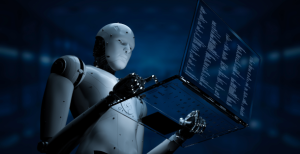 In today’s interconnected digital landscape, cybersecurity threats continue to evolve at an alarming rate. One such threat that keeps security professionals awake at night is the rise of AI-powered DDoS attacks. These attacks combine the destructive power of distributed denial-of-service (DDoS) attacks with the sophistication and agility of artificial intelligence (AI) technology. Understanding the implications of AI-powered DDoS attacks is crucial for organizations of all sizes and industries to protect their networks and data.
In today’s interconnected digital landscape, cybersecurity threats continue to evolve at an alarming rate. One such threat that keeps security professionals awake at night is the rise of AI-powered DDoS attacks. These attacks combine the destructive power of distributed denial-of-service (DDoS) attacks with the sophistication and agility of artificial intelligence (AI) technology. Understanding the implications of AI-powered DDoS attacks is crucial for organizations of all sizes and industries to protect their networks and data.
The Anatomy of an AI-Powered DDoS Attack
AI-powered DDoS attacks differ from traditional attacks in that they are fully automated, highly agile, and incredibly effective. Attackers leverage data mining techniques to gather vast amounts of information, feeding it into complex algorithms that mimic decision-making processes. By employing supervised or unsupervised machine learning (ML), hackers can develop AI models capable of bypassing DDoS defensive countermeasures.
The attack lifecycle typically consists of three stages: delivery, penetration, and exploitation. At each stage, AI algorithms enable attackers to adapt and modify their strategies based on real-time data and analysis. This flexibility allows them to identify targets that are less protected and optimize their attack distribution for maximum impact.
The Unstoppable Force: Automated DDoS Attacks
The power of DDoS attacks lies in their ability to disrupt and potentially bring down websites and online services. Automation and scripting have made these attacks more popular, enabling hackers to process vast amounts of security telemetry data using AI engines and machine learning models. By continuously analyzing and refining their attack techniques, hackers can identify vulnerabilities and weaknesses in their targets, making their attacks more potent and harder to defend against.
The Role of Automation in Countering AI-Powered DDoS Attacks
Automation plays a crucial role in defending against AI-powered DDoS attacks. Security operations (SecOps) teams can leverage automation to block attacks, establish preemptive rules and controls, and analyze AI-processed datasets to identify attack patterns and trends. By using automation to respond in real-time to evolving threats, organizations can mitigate the impact of DDoS attacks and protect their network infrastructure.
The Battle of AI-DDoS Attacks
In the battlefield of AI-DDoS attacks, both attackers and defenders constantly adapt and learn from each other’s tactics. Hackers not only target organizations but also face attacks from rival cybercriminals. This dynamic creates a constant exchange of offensive and defensive strategies, where both parties leverage AI and automation to gain an advantage.
Hackers employ AI to adjust their threat vectors based on real-time analysis, while organizations use AI and automation to defend against attacks and launch countermeasures. This ongoing battle of wits and technological prowess has led to a rapid evolution of cybersecurity practices, with each side continuously innovating to gain the upper hand.
The Implications for Cybersecurity
The emergence of AI-powered DDoS attacks poses significant challenges for cybersecurity professionals. Traditional defense mechanisms that rely on human intervention and rule-based systems are ill-equipped to combat the sophistication and speed of AI algorithms. To effectively defend against these attacks, organizations need to embrace advanced technologies such as AI, machine learning, and automation in their security strategies.
Furthermore, collaboration and information sharing within the cybersecurity community are crucial. By sharing insights, best practices, and threat intelligence, organizations can collectively strengthen their defenses and stay one step ahead of cybercriminals.
Conclusion
AI-powered DDoS attacks represent a formidable threat in today’s digital landscape. The fusion of AI technology with the devastating impact of DDoS attacks has created a new battlefield in cybersecurity. Organizations must understand the anatomy of these attacks, the role of automation in defense, and the ongoing battle between attackers and defenders.
By staying informed, adopting advanced security measures, and fostering collaboration within the cybersecurity community, organizations can enhance their resilience against AI-powered DDoS attacks. Only through proactive measures and a holistic approach to cybersecurity can we effectively mitigate the risks and protect our digital infrastructure in this rapidly evolving threat landscape. Donny Chong, Product & Marketing Director, Nexusguard
Donny Chong, Product & Marketing Director, Nexusguard
Donny is a highly accomplished professional with fifteen years of experience in the technology and telecommunications industries. Donny’s responsibilities encompass the design and management of the company’s solutions for both Communications Service Providers (CSPs) and enterprise customers.
Source:
What Is An AI-Powered DDoS Attack?
https://blog.nexusguard.com/what-is-an-ai-powered-ddos-attack
If you haven't already, please take our Reader Survey! Just 3 questions to help us better understand who is reading Telecom Ramblings so we can serve you better!
Categories: Artificial Intelligence · Industry Viewpoint · Security






Discuss this Post